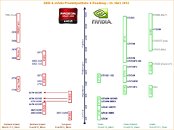Tuesday, April 10th 2012

NVIDIA GK106 GPU Detailed
Following the launch of a couple of more GK104-based SKUs, namely GeForce GTX 670 Ti, and GeForce GTX 670, some time in May; NVIDIA will launch its third (after GK104 and GK107) Kepler architecture-based silicon, codenamed GK106. GK106 will make up sub-$200 SKUs, and succeeds the GF116, on which SKUs such as the GeForce GTX 550 Ti, are based. The GK106 will make up at least one known desktop SKU, called GeForce GTX 660.Its specifications are listed below.
Source:
3DCenter.org
- 28 nm, around 210 mm² die-area, Kepler architecture
- Two Graphics Processing Clusters (GPCs), four Streaming Multiprocessors (SMXs)
- 768 CUDA cores
- 64 TMUs, 24 ROPs
- 192-bit wide GDDR5 memory interface, holding 1.5 GB or 2 GB memory
- PCI-Express 3.0 bus interface
- Around 130W TDP
- Speculated performance comparable to GTX 560 Ti and HD 6950, competitive to Radeon HD 7800 series

26 Comments on NVIDIA GK106 GPU Detailed
It shows the 7970 as being around 450 with the GTX680 being about 500.
if 660 is ~130w it means single 6-pin power, which is nice
let's wait and see
Like I said in a previous post, I expect this to be paired against the 7850 and beat it at stock. While 7850 may be more architecturally sound with 15-33% more resources on paper, we're again talking a part that will be clocked in the neighborhood of 25% higher on average. When the equivalent of 896 shaders takes on 1024 at 25% higher clock and the limiting factor is most-often shader performance on these configurations, that makes a difference. When 64 texture units take on 80 at 25% higher clock, that's pretty much a tie. When 24 ROPs (with better raster performance) take on 32 ROPs when neither needs that many...it doesnt particularly matter.
Also, according to how I calculate average bandwidth requirements (by bottlenecks on past products) 5ghz on a 192-bit bus fits 680 clocks perfectly...in theory it should be more efficient in that regard than 680 at stock. Memory bandwidth for Pitcairn OTOH is obviously built around the clocks/configuration of 7870 (which is also perfectly matched). It may help 7850 on some occasions, but not to any large degree.
Then you have overclocking...which on 7850 is a complete PITA. The vbios limits it to 1050mhz on pretty much every model (granted ASUS has a work-around), most lack voltage control, and even beyond that there is powertune limiting it to 150w.
I don't think it will be a stretch to say, theoretically, a 1200mhz 660 will compete with a 1050mhz 7850. Sure, 7850 can probably do better if you get the right model and/or want to spend the time figuring it out, but I think nvidia will make the process easier. Given what we've seen on 680 and 28nm as a whole, 1200mhz is also a realistic speed to attain (especially on the fully-working chips). So, more-or-less a wash...but it's important to remember reviews are at stock, and what most people use to compare.
$350 is too much for a 7870, at $100 less it would be a bit better buy, and now that gtx 660 will compete with 7850, the 7870 won't budge from that price.....
Nvidia will probably use some pressure from the top with the GTX670 (i.e loosely beating HD7870 for $300) and hopefully price the GTX660 well below $250 while being cosmetically faster than HD7850. In the end this GTX550 replacement card was probably meant to be sold at $150.
PS: IMO like in the GF106 the 192 bit memory interface is a dumb idea. 128 bit would suffice for what is otherwise half the chip and the extra 64 bit channel will probably do nothing but make it much larger.
Keep hopeing :rockout: